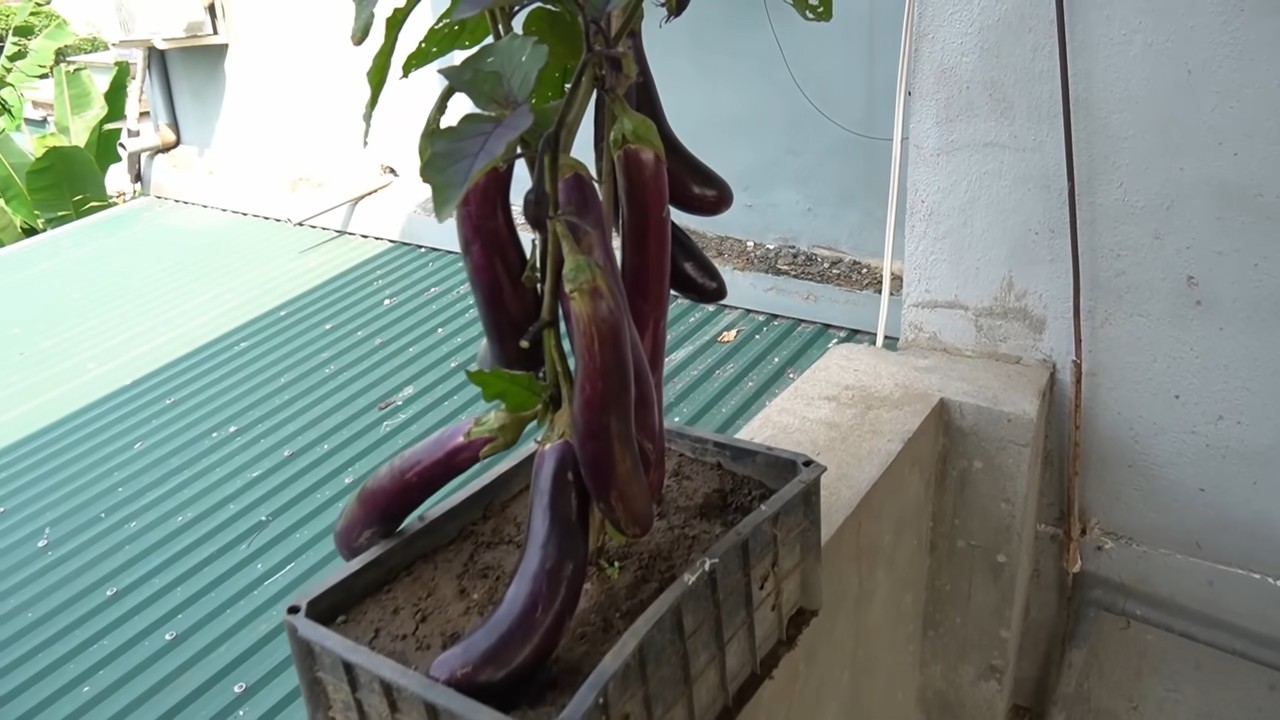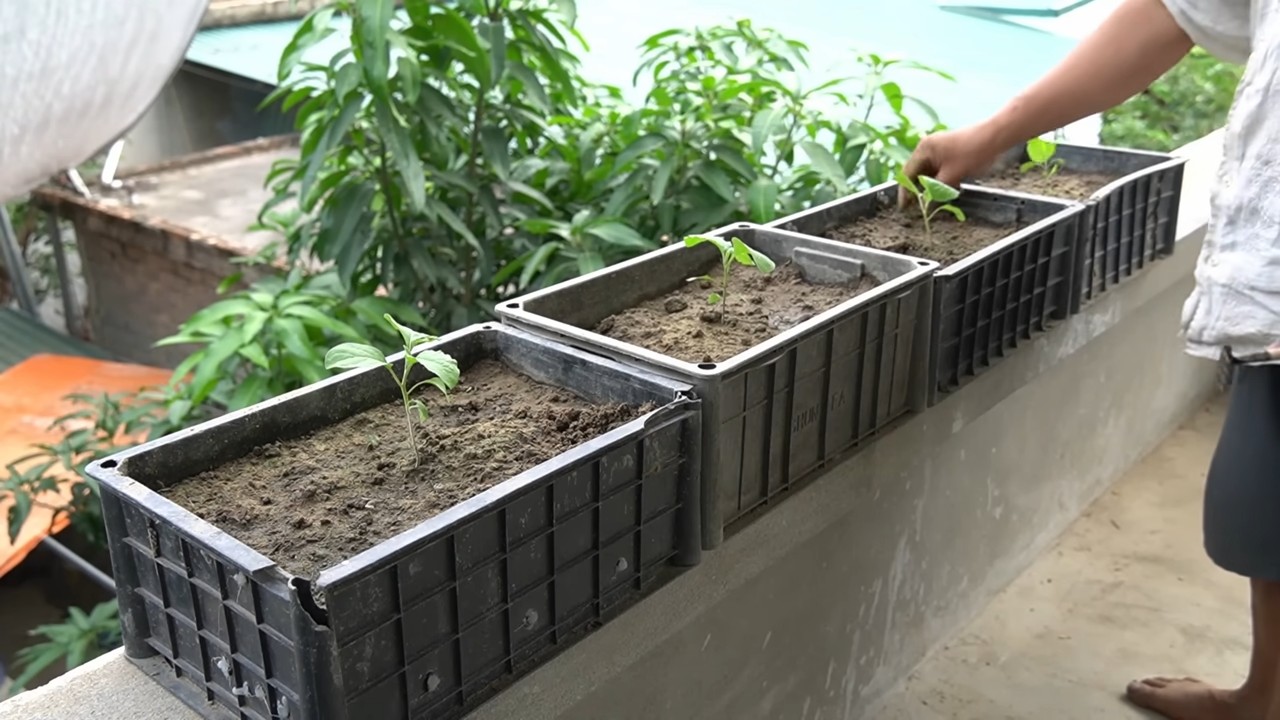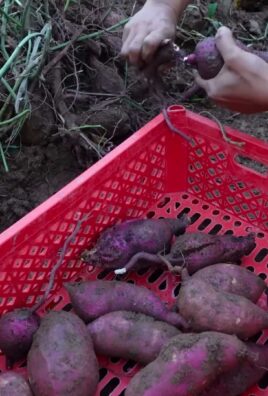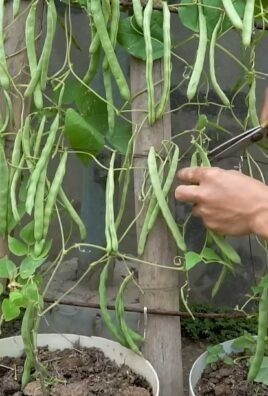Bucket gardening eggplants: sounds like a fun and fruitful adventure, doesn’t it? I’m so excited to share some simple yet effective DIY tricks that will have you harvesting beautiful, plump eggplants right from your own backyard (or balcony!). Forget sprawling gardens and back-breaking labor; we’re talking about container gardening magic!
Eggplants, with their glossy purple skin, have a rich history, originating in Asia and making their way across the globe. They’ve been a staple in various cuisines for centuries, adding depth and flavor to countless dishes. But you don’t need to be a seasoned chef or a master gardener to enjoy the taste of homegrown eggplants.
Let’s face it, not everyone has the space or time for a traditional garden. That’s where bucket gardening eggplants comes in! This method is perfect for apartment dwellers, busy individuals, or anyone who wants to enjoy fresh produce without the hassle of extensive gardening. Plus, it’s incredibly rewarding to nurture a plant from seedling to harvest, knowing you grew it yourself. I’m here to guide you through the process with easy-to-follow steps and insider tips that will ensure your eggplant bucket garden thrives. Get ready to enjoy delicious, homegrown eggplants all season long!

DIY Bucket Gardening: Growing Eggplants Like a Pro!
Hey there, fellow gardening enthusiasts! I’m so excited to share my tried-and-true method for growing plump, juicy eggplants right in buckets. Forget sprawling gardens – this is perfect for patios, balconies, or even just maximizing your sunny space. Trust me, with a little know-how, you’ll be harvesting delicious eggplants in no time!
Why Bucket Gardening for Eggplants?
Before we dive in, let’s talk about why bucket gardening is fantastic for eggplants:
* Space-Saving: Ideal for small spaces like apartments, balconies, or patios.
* Portability: Move your plants to chase the sun or protect them from harsh weather.
* Controlled Environment: Easier to manage soil quality, watering, and pest control.
* Early Harvest: Buckets warm up faster than the ground, potentially leading to an earlier harvest.
* Less Weeding: Say goodbye to endless weeding sessions!
What You’ll Need: The Essential Supplies
Okay, let’s gather our supplies. Here’s what you’ll need to get started:
* Buckets: 5-gallon buckets are the sweet spot. Make sure they’re food-grade if you’re using recycled ones. Dark-colored buckets absorb heat, which eggplants love, but can get too hot in scorching climates. Consider lighter colors if you live in a very hot area.
* Eggplant Seedlings: You can start from seeds, but buying seedlings from a local nursery is much faster and easier, especially for beginners. Choose a variety that’s well-suited to your climate and bucket gardening. Some good options include ‘Black Beauty,’ ‘Ichiban,’ ‘Little Fingers,’ and ‘Patio Baby.’
* Potting Mix: Don’t use garden soil! It’s too heavy and doesn’t drain well in containers. Opt for a high-quality potting mix specifically designed for containers. I personally love a mix of peat moss, perlite, and vermiculite.
* Drainage Material: Gravel, pebbles, or even broken pottery shards to place at the bottom of the bucket for drainage.
* Fertilizer: A slow-release fertilizer formulated for vegetables is ideal. You’ll also want a liquid fertilizer for supplemental feeding.
* Watering Can or Hose: For, well, watering!
* Trowel or Small Shovel: For planting and transplanting.
* Gloves (Optional): To keep your hands clean.
* Stakes or Cages (Optional): Eggplants can get quite heavy, so staking or caging them can prevent them from toppling over.
* Mulch (Optional): To help retain moisture and suppress weeds. Straw, wood chips, or even shredded leaves work well.
Step-by-Step Guide: Planting Your Eggplant in a Bucket
Alright, let’s get our hands dirty! Here’s how to plant your eggplant seedlings in buckets:
1. Prepare the Buckets:
* First, make sure your buckets are clean.
* Drill drainage holes in the bottom of each bucket. I usually drill about 4-5 holes, each about ½ inch in diameter. This is crucial to prevent waterlogging, which can lead to root rot.
* Add a layer of drainage material (gravel, pebbles, etc.) to the bottom of each bucket. This helps improve drainage and prevents the potting mix from clogging the drainage holes. A 2-3 inch layer is usually sufficient.
2. Fill with Potting Mix:
* Fill the buckets with potting mix, leaving about 2-3 inches of space at the top. This space is important for watering, as it prevents water from overflowing.
* Gently pat down the potting mix to remove any air pockets. Don’t pack it too tightly, as this can hinder drainage.
3. Plant the Seedlings:
* Carefully remove the eggplant seedlings from their nursery pots. Gently loosen the roots with your fingers to encourage them to spread out.
* Dig a hole in the center of each bucket, large enough to accommodate the root ball of the seedling.
* Place the seedling in the hole, ensuring that the top of the root ball is level with the surface of the potting mix.
* Fill in the hole with potting mix, gently firming the soil around the base of the plant.
4. Water Thoroughly:
* Water the newly planted seedlings thoroughly until water drains out of the drainage holes. This helps settle the soil and ensures that the roots are well-hydrated.
5. Add Fertilizer:
* Sprinkle a slow-release fertilizer around the base of each plant, following the instructions on the fertilizer package. This will provide the plants with a steady supply of nutrients over time.
6. Mulch (Optional):
* Apply a layer of mulch around the base of each plant to help retain moisture, suppress weeds, and regulate soil temperature.
7. Stake or Cage (Optional):
* If you’re using stakes or cages, install them now to provide support for the growing plants. Insert the stakes into the soil near the base of the plant, being careful not to damage the roots. Secure the plant to the stake with plant ties.
Caring for Your Bucket Eggplants: The Key to a Bountiful Harvest
Now that your eggplants are planted, it’s time to provide them with the care they need to thrive. Here’s what you need to know:
* Sunlight: Eggplants need at least 6-8 hours of direct sunlight per day. Place your buckets in a sunny location where they will receive plenty of light. If you don’t have enough sunlight, you can supplement with grow lights.
* Watering: Water your eggplants regularly, especially during hot, dry weather. Check the soil moisture by sticking your finger into the soil. If the top inch of soil feels dry, it’s time to water. Water deeply, until water drains out of the drainage holes. Avoid overwatering, as this can lead to root rot.
* Fertilizing: In addition to the slow-release fertilizer, you’ll need to supplement with liquid fertilizer every 2-3 weeks. Use a balanced fertilizer or one specifically formulated for vegetables. Follow the instructions on the fertilizer package.
* Pruning: Pruning can help improve air circulation and encourage fruit production. Remove any suckers (small shoots that grow from the base of the plant) and any yellowing or diseased leaves. You can also pinch off the tips of the branches to encourage bushier growth.
* Pest and Disease Control: Keep an eye out for pests and diseases. Common eggplant pests include aphids, flea beetles, and spider mites. Common diseases include powdery mildew and blossom-end rot. Treat any problems promptly with appropriate insecticides or fungicides. For blossom-end rot, ensure consistent watering and consider adding calcium to the soil.
* Pollination: Eggplants are self-pollinating, but they benefit from insect pollination. Encourage pollinators to visit your garden by planting flowers nearby. You can also hand-pollinate the flowers by gently shaking the plant or using a small paintbrush to transfer pollen from one flower to another.
Troubleshooting Common Problems
Even with the best care, you might encounter some problems along the way. Here are some common issues and how to address them:
* Yellowing Leaves: This can be caused by overwatering, underwatering, nutrient deficiencies, or pests. Check the soil moisture and adjust your watering accordingly. Fertilize with a balanced fertilizer. Inspect the leaves for pests and treat as needed.
* Blossom Drop: This is when the flowers fall off the plant without producing fruit. It can be caused by temperature stress (too hot or too cold), lack of pollination, or nutrient deficiencies. Ensure consistent watering and fertilizing. Hand-pollinate the flowers if necessary.
* Blossom-End Rot: This is a condition where the bottom of the fruit develops a dark, sunken spot. It’s caused by a calcium deficiency. Ensure consistent watering and consider adding calcium to the soil.
* Pest Infestations: Regularly inspect your plants for pests. Treat any infestations promptly with appropriate insecticides. You can also use organic pest control methods, such as insecticidal soap or neem oil.
Harvesting Your Eggplants: The Moment of Truth!
The moment you’ve been waiting for! Here’s how to harvest your eggplants:
* Timing: Harvest your eggplants when they are glossy, firm, and have reached their mature size. The skin should be smooth and unblemished. Gently press the skin with your finger. If it springs back, the eggplant is ready to harvest. If it feels hard and doesn’t give, it’s probably overripe.
* Technique: Use a sharp knife or pruning shears to cut the eggplant from the plant. Leave about an inch of stem attached to the fruit.
*

Conclusion
So, there you have it! Transforming a simple bucket into a thriving eggplant haven is not just a gardening hack; it’s a gateway to fresh, homegrown goodness right at your doorstep. We’ve walked you through the process, highlighting the ease, affordability, and sheer satisfaction of nurturing your own eggplant plants in containers.
Why is this DIY trick a must-try? Because it democratizes gardening. No sprawling acreage is required, no back-breaking tilling of the soil. Just a bucket, some quality soil, a healthy eggplant seedling, and a little bit of love. It’s perfect for apartment dwellers, balcony gardeners, or anyone with limited space who craves the taste of vine-ripened vegetables. Beyond the convenience, bucket gardening eggplants offers superior control over soil quality, watering, and pest management, leading to healthier plants and a more bountiful harvest. You’re essentially creating the perfect microclimate for your eggplants to flourish.
But the beauty of this method lies in its adaptability. Feel free to experiment with different eggplant varieties. From the classic globe-shaped ‘Black Beauty’ to the slender Japanese eggplants or the vibrant Thai green varieties, the possibilities are endless. Consider companion planting within your bucket. Marigolds can deter pests, while basil can enhance the flavor of your eggplants. You can also adjust the size of your bucket depending on the variety of eggplant you choose. Larger varieties will benefit from larger buckets, while smaller varieties can thrive in smaller containers.
Don’t be afraid to get creative with your container decor! Paint your buckets, add decorative stones, or even create a vertical garden by stacking multiple buckets. This is your chance to personalize your gardening experience and add a touch of flair to your outdoor space.
We’ve armed you with the knowledge and inspiration to embark on your own bucket gardening adventure. Now, it’s time to get your hands dirty! Head to your local garden center, grab a bucket (or two, or three!), and start planting.
We are confident that you’ll be amazed by the results. Imagine the satisfaction of harvesting your own plump, juicy eggplants, knowing that you nurtured them from tiny seedlings to thriving plants. Picture the delicious meals you’ll create, from classic eggplant parmesan to flavorful stir-fries and grilled vegetable skewers.
But most importantly, we want to hear about your experience! Share your photos, tips, and triumphs with us. What varieties did you choose? What challenges did you face? What delicious dishes did you create? Your feedback will not only inspire other gardeners but also help us refine and improve this guide.
So, go ahead, give bucket gardening eggplants a try. We promise you won’t regret it. Happy gardening!
Frequently Asked Questions (FAQ)
What size bucket is best for growing eggplants?
The ideal bucket size for growing eggplants is typically between 5 to 10 gallons. A 5-gallon bucket is generally sufficient for smaller eggplant varieties, while larger varieties will benefit from a 10-gallon bucket or even larger. The key is to provide enough space for the roots to develop properly. If the roots become too crowded, the plant’s growth will be stunted, and it may not produce as many eggplants. Ensure the bucket has drainage holes to prevent waterlogging, which can lead to root rot. Consider the mature size of the eggplant variety you’re planting when choosing your bucket size.
What type of soil should I use for bucket gardening eggplants?
Eggplants thrive in well-draining, nutrient-rich soil. A good potting mix specifically formulated for vegetables is an excellent choice. Avoid using garden soil directly in your buckets, as it can become compacted and doesn’t drain as well. You can also create your own potting mix by combining equal parts of compost, peat moss (or coconut coir), and perlite or vermiculite. Compost provides essential nutrients, peat moss (or coconut coir) helps retain moisture, and perlite or vermiculite improves drainage. Adding a slow-release fertilizer to the soil at planting time can also provide a steady supply of nutrients throughout the growing season.
How often should I water my eggplant plants in buckets?
Watering frequency depends on several factors, including the weather, the size of the bucket, and the stage of growth of the eggplant plant. Generally, you should water your eggplant plants when the top inch of soil feels dry to the touch. During hot, dry weather, you may need to water them daily. Avoid overwatering, as this can lead to root rot. When watering, water deeply until water drains out of the drainage holes. This ensures that the roots are thoroughly moistened. Mulching around the base of the plant can help retain moisture and reduce the need for frequent watering.
How much sunlight do eggplants need when grown in buckets?
Eggplants are sun-loving plants and require at least 6-8 hours of direct sunlight per day to thrive. Choose a location for your buckets that receives plenty of sunlight throughout the day. If you live in a particularly hot climate, you may need to provide some afternoon shade to prevent the plants from overheating. If you’re growing your eggplants indoors, you’ll need to supplement with grow lights to provide adequate light. Rotate the buckets regularly to ensure that all sides of the plant receive equal sunlight.
What are some common pests and diseases that affect eggplants in buckets, and how can I prevent them?
Common pests that can affect eggplants include aphids, flea beetles, and spider mites. Diseases include fungal diseases like early blight and verticillium wilt. To prevent pests, inspect your plants regularly for signs of infestation. You can use insecticidal soap or neem oil to control aphids, flea beetles, and spider mites. Companion planting with marigolds can also help deter pests. To prevent fungal diseases, ensure good air circulation around the plants and avoid overhead watering. Water at the base of the plant to prevent the leaves from getting wet. If you notice any signs of disease, remove the affected leaves immediately. Using a fungicide can also help control fungal diseases.
Can I move my eggplant buckets if needed?
Yes, one of the advantages of bucket gardening is the portability of the plants. You can easily move your eggplant buckets to follow the sun, protect them from frost, or bring them indoors during extreme weather conditions. However, be mindful of the weight of the buckets, especially when they are filled with soil and mature plants. If the buckets are too heavy to lift, you can use a dolly or a wheeled plant stand to move them.
How do I know when my eggplants are ready to harvest?
Eggplants are typically ready to harvest when they are firm, glossy, and have reached their mature size and color. The skin should be smooth and unblemished. Gently press the eggplant with your thumb; if it gives slightly, it’s ready to harvest. Use a sharp knife or pruning shears to cut the eggplant from the plant, leaving a short stem attached. Harvesting eggplants regularly encourages the plant to produce more fruit.
Can I grow eggplants in buckets in colder climates?
Yes, you can grow eggplants in buckets in colder climates, but you’ll need to take some precautions. Start your eggplant seedlings indoors 6-8 weeks before the last expected frost. Once the weather warms up and the risk of frost has passed, you can transplant the seedlings into your buckets. If you experience a late frost, you can easily move the buckets indoors to protect the plants. Choose a variety of eggplant that is known to be cold-tolerant. You may also need to provide some extra protection, such as a cold frame or row covers, to extend the growing season.
How do I fertilize my eggplant plants in buckets?
Eggplants are heavy feeders and require regular fertilization to produce a bountiful harvest. Start by incorporating a slow-release fertilizer into the soil at planting time. Then, fertilize every 2-3 weeks with a balanced liquid fertilizer, such as a 10-10-10 or a 20-20-20. Follow the instructions on the fertilizer label for proper application rates. You can also supplement with organic fertilizers, such as compost tea or fish emulsion. Avoid over-fertilizing, as this can lead to excessive foliage growth and fewer fruits.
Can I reuse the soil from my eggplant buckets for other plants?
It’s generally not recommended to reuse the soil from your eggplant buckets for other plants, especially if the eggplants were affected by any diseases. Eggplants are susceptible to certain soilborne diseases that can persist in the soil and infect other plants. If you do choose to reuse the soil, you should sterilize it first by baking it in the oven at 180 degrees Fahrenheit for 30 minutes. However, it’s often easier and safer to simply discard the old soil and use fresh potting mix for your next planting. You can add the old soil to your compost pile to enrich it.




Leave a Comment